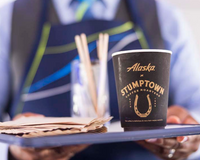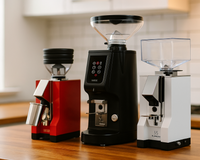Introduction: Why Grind Size Matters For Espresso
When it comes to brewing the perfect espresso, one of the most critical factors is the grind size of your coffee beans. This seemingly small detail can dramatically affect the extraction process, influencing not only the flavor but also the overall quality of your espresso shot. For coffee enthusiasts and aficionados alike, understanding and mastering the right grind size is essential to achieving that ideal cup.
The Impact of Grind Size on Espresso Extraction
Extraction is the process of pulling flavor compounds from your coffee beans using water, and grind size plays a pivotal role in this. A finer grind increases the surface area exposed to water, allowing for a more rapid extraction. This is crucial for espresso, which uses a short brew time and high pressure to extract flavor. If the grind is too coarse, the water will pass through too quickly, resulting in a weak and under-extracted shot lacking in richness and depth. Conversely, if the grind is too fine, it can cause over-extraction, leading to a bitter and harsh flavor profile.
Flavor and Quality: The Delicate Balance
The right grind size helps in achieving a balance between the sweet, acidic, and bitter components of the coffee. For espresso, the goal is to find a grind that allows for a shot that is rich, complex, and balanced. This means a grind fine enough to slow the water flow and extract the desired flavors, but not so fine that it leads to over-extraction and bitterness. The ideal espresso shot should have a robust flavor, a thick and creamy body, and a velvety mouthfeel, all of which are heavily influenced by the grind size.
RELATED: WHY YOUR TAP WATER MIGHT BE THE SECRET TO BETTER COFFEE
 Understanding Espresso and Its Requirements
Understanding Espresso and Its Requirements
What Is Espresso?
Espresso is a concentrated coffee beverage brewed by forcing a small amount of nearly boiling water through finely ground coffee beans under high pressure. This method, originating from Italy, is known for producing a rich, robust, and aromatic cup of coffee in a short amount of time.
Characteristics of Espresso Compared to Other Brewing Methods
1. Brewing Time: One of the most distinctive aspects of espresso is its quick brewing time, typically taking about 25 to 30 seconds. This is significantly faster compared to methods like drip coffee, which can take several minutes.
2. Pressure: Espresso machines use a pressure of about 9 bar (130 psi) to extract coffee, which is much higher than other methods. This high pressure is crucial for creating the espresso's signature crema—a creamy, foamy layer on top of the coffee that adds to its rich texture and flavor.
3. Temperature: The water temperature for brewing espresso is usually around 90-96°C (194-205°F), which is carefully controlled to ensure optimal extraction without burning the coffee.
4. Grind Size: The grind size for espresso is much finer compared to other brewing methods like French press or drip coffee. A fine grind is essential to create resistance to the water flow, facilitating proper extraction under high pressure.
5. Flavor Profile: Due to its concentrated nature, espresso has a more pronounced flavor profile with higher acidity and body compared to regular coffee. This makes it an ideal base for other coffee drinks like lattes, cappuccinos, and Americanos.
6. Volume: Typically, a shot of espresso is about 30 ml (1 oz), which is much less than a standard cup of coffee. This small volume contains a similar amount of caffeine as a larger cup of drip coffee, packed into a denser, more flavorful shot.
Ideal Grind Size for Espresso: A Detailed Guide
For espresso, the universally recommended grind size is fine, akin to table salt.
This fine grind is crucial for espresso's unique brewing method, which involves high pressure pushing water through tightly packed grounds.
Why Fine Grind Size Is Recommended
- Optimal Extraction: A fine grind increases the surface area of coffee exposed to water, allowing for a quick and efficient extraction of flavors. This is essential for espresso's short brewing time.
- Resistance to Water Flow: The fine particles create the necessary resistance to water flow, enabling the build-up of pressure required to extract rich flavors and to form the characteristic creamy crema on top.
- Flavor and Crema: The fine grind helps in extracting the complex flavors and essential oils from the coffee, which contribute to the espresso’s full-bodied flavor and aromatic crema.
Tips on Achieving the Right Grind Size at Home
- Invest in a Quality Grinder: A burr grinder is preferable for a consistent fine grind. Blade grinders can create uneven particles and might not achieve the required fineness for espresso.
- Adjust the Settings: Start with the grinder's fine setting and make small adjustments until you find the perfect grind. The exact setting can vary between grinders.
- Experiment: Each espresso machine may respond differently to the grind size due to factors like pressure and temperature. Experimentation is key to determining the best grind for your specific machine.
YOU MIGHT LIKE: BENEFITS OF A QUIET COFFEE GRINDER
Buying Pre-Ground Coffee:
While it's always best to grind you beans directly before pulling a shot of espresso, pre-ground is an option.
- Select Espresso-Specific Grinds: If you prefer to buy pre-ground coffee, look for bags labeled specifically for espresso, which are ground to the right size.
- Freshness Matters: Purchase small amounts of pre-ground coffee to ensure freshness, as ground coffee loses its flavor quickly after being exposed to air.
Achieving Consistency
Consistent grind size is crucial for consistent quality in your espresso shots. When adjusting your grinder, always grind a small amount of coffee first to clear any previously used coffee from the burrs. This ensures that the adjustments you make reflect accurately in the grind size.

How to Test and Adjust Your Grind Size
Finding the right grind size for espresso is a crucial step for achieving the perfect shot. Here’s a step-by-step process to help you test different grind sizes and recognize signs of under-extraction and over-extraction:
Step-by-Step Guide to Finding Your Perfect Espresso Grind
Step 1: Start with a Baseline Grind
- Set your grinder to a medium-fine grind as a starting point. This is typically a good baseline for most espresso machines.
Step 2: Pull Your First Shot
- Prepare your espresso machine by warming it up according to the manufacturer’s instructions.
- Measure and tamp your coffee: Use about 18-20 grams of coffee for a double shot. Tamp evenly to ensure uniform extraction.
- Brew the shot and observe the time it takes to extract about 2 ounces (60 ml). Ideally, this should take about 25-30 seconds.
Step 3: Assess the Shot
- Examine the flow: It should be steady and look like warm honey dripping off a spoon. If it rushes out, the grind is too coarse; if it drips or stalls, it’s too fine.
- Taste the espresso: It should be rich, balanced, and have a pleasant aftertaste. Sour flavors typically indicate under-extraction, while bitterness suggests over-extraction.
Step 4: Adjust the Grind
- Adjust your grinder: Make small changes to the grind setting. If the shot was too quick and sour, make the grind finer. If it was slow and bitter, make the grind coarser.
- Repeat the process: Brew another shot with the new settings, following the same steps as before.
Step 5: Fine-Tune and Repeat
- Continue to adjust and taste: It may take several adjustments to find the optimal grind size. Each time, make only slight changes to the grind setting, as small adjustments can significantly impact the extraction.
- Record your results: Keeping track of your changes and the resulting tastes will help you achieve consistent results and understand your preferences.
Step 6: Recognize Signs of Proper Extraction
- Ideal extraction: The espresso shot will have a rich, caramel-like crema, and the flavor will be well-balanced, neither too bitter nor too acidic.
Troubleshooting Common Issues
- Under-extraction: Often results in a thin crema and a sour, quick shot. The espresso may also lack body and depth.
- Over-extraction: Typically produces a very bitter taste with a dark, thick crema. The shot might also run too slowly, indicating the grind is too fine.















